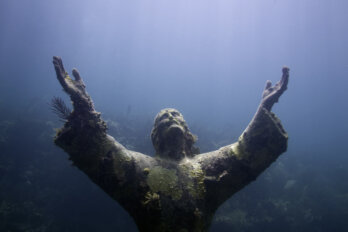At around two in the morning on October 26, Newfoundland and Labrador premier Dwight Ball began a quiet media scrum at the Confederation Building in St. John’s. Since two-thirty the previous afternoon, Ball and Indigenous leaders from Labrador had been behind closed doors, working toward a resolution that would end the twelve-day hunger strike of Inuk visual artist Billy Gauthier, writer Delilah Saunders, and Jerry Kohlmeister.
Work at Muskrat Falls, a project of provincial Crown corporation Nalcor Energy, had been at a standstill for three days, after about sixty self-identified land protectors broke through security gates and walked down ten kilometres to begin a peaceful occupation of the project’s work camp in Labrador. The occupiers included children and elders, and were accompanied by theIndependent.ca journalist Justin Brake. Brake shared the events via live stream; people across the province witnessed, in real time, the land protectors’ surprisingly warm welcome by workers, and an unprecedented level of cooperation and unity between Inuit, Innu, and settler Labradorians.
Located about twenty-five kilometres west of Happy Valley-Goose Bay, the Muskrat Falls hydroelectric generating station is part of Nalcor’s ambitious Lower Churchill Project. Construction on the station began in 2013, and it was initially expected to be operational by 2017. As of right now, there is no expectation that the plant will produce before 2019, and Nalcor’s budget has spun from seven billion to upwards of eleven billion dollars.
There are enough things wrong with the Muskrat Falls project to make one wonder if it can be made right at all: considered an economic disaster from all perspectives, it also poses considerable ecological and social threats. The project has been criticized by such diverse voices as Council of Canadians chairperson Maude Barlow, prominent Mi’kmaq lawyer Pam Palmater, Inuk performer and activist Tanya Tagaq, Newfoundland novelist Lisa Moore, and Newfoundland and Labrador consumer advocate Dennis Browne, who told CBC radio that the project “should never have seen the light of day.”
Even Nalcor president Stan Marshall admitted last June that the project “was not the right choice for the power needs of this province.” In April, Marshall seemed to suggest to reporters that he was “not married” to Muskrat Falls, but by summer he had changed his tune. Apparently, in spite of the project’s ballooning budget, expected power rate increases in the ballpark of $150 per household per month by 2022, an ongoing dispute with Astaldi (the Italian company contracted to build the generating station), it was simply too late to cancel.
When the leaders finally emerged, they appeared exhausted. Anastasia Qupee, grand chief of the Innu Nation, thanked Ball and told reporters,“We have reached an agreement that will protect the health of our people and our environment.” Nunatsiavut president Johannes Lampe spoke first in Inuktitut, then in English, recognizing the work of the hunger strikers and land protectors in Muskrat Falls and across the province. “This has been a tense and happy day for all concerned,” he said, but his tone, and the tone around him, was anything but cheerful. Todd Russell, leader of the NunatuKavut Community Council, took to the microphone to tell “all of those who have walked, who have advocated, the land protectors, that you have made progress, that you have achieved much of what you set out to achieve.”
Live feeds and rapidly-shared Facebook photos showed a tired but jubilant Gauthier, Saunders, and Kohlmeister in Ottawa, where the trio had travelled for a rally to try and get federal attention. The hunger strikers, who approved the wording of the agreement, had their first taste of arctic char after a long and very public journey. Their commitment and clarity of purpose moved Canadians in a way that nothing out of Labrador had before.
But back in St. John’s, folks watching the late-night scrum via smartphone on the Confederation Building steps responded with something between shock and grief; while the agreement signalled progress, it dealt with only one of a number of concerns about the project.
For years, there has been vocal opposition among Newfoundlanders to Nalcor’s project on financial grounds: having briefly tasted life as a “have” province, the idea of paying off an $11-billion energy boondoggle for generations is simply too outrageous for many to contemplate. Newfoundlanders across tax brackets and sectors have become understandably resentful of bearing the cost of their government’s bad deals.
But in Labrador, the long-running concerns about Muskrat Falls come from a different place: the need to preserve residents’ health, safety, and way of life. Two major worries dominate: methylmercury contamination of the food web of Lake Melville, and the possibility of a dam collapse that would divert water from the falls, resulting in loss of power from the generation plant, and quite possibly loss of human life downstream.
Methylmercury is a powerful neurotoxin. Its effects include developmental delays, lowered IQ, language acquisition issues in children, and dexterity problems and cardiovascular damage in adults. In its pure state, mercury isn’t absorbed by the human body, so its presence (natural or as a result of industry) in soil and organic matter is relatively harmless. Under flood conditions, however, mercury is broken down by microbes and converted to methylmercury, which the body absorbs readily. Flooding the reservoir at Muskrat Falls will put forty-one square kilometres of land underwater, exposing mercury-containing topsoil to decomposing trees and leaf litter, and creating a spike in methylmercury levels within seventy-two hours. Once in the reservoir, contaminated water would be released into the falls and the river, and then into Lake Melville, where the methylmercury would work its way through plankton and into fish, sea birds, and seals.
Because methylmercury bioaccumulates, those toward the top of the food chain are affected at a higher rate than the organisms at the bottom. While contamination in water might be relatively low, methylmercury levels in someone whose diet is rich in contaminated foods could be dangerously high. Babies and young children are especially vulnerable, as methylmercury can pass from mother to infant both in utero and through breast milk.
For many Labradorians, especially Indigenous Labradorians, a rise in methylmercury levels would alter life completely, forcing them to choose between prohibitively expensive, low-quality supermarket foods, and highly nourishing, culturally appropriate but contaminated fish and game. It’s a choice no-one wants to have to make.
If followed to the letter, the agreement made in St. John’s and approved by the hunger strikers should mitigate methylmercury contamination by requiring Nalcor to remove all organic material—topsoil, trees, and leaf litter—from the reservoir area before flooding. Memorial University’s Trevor Bell, who has worked for years with the Nunatsiavut government to study the possibility of methylmercury contamination from the Muskrat Falls project, calls the agreement “a game changer” and believes it sets a strong precedent by requiring governments and corporations to work with independent researchers to ensure the safety of food chains in and around reservoir areas.
But that still leaves Labrador residents concerned about the stability of the North Spur, which connects Muskrat Falls to an area called Spirit Mountain, and which is composed of layers of sand and marine clay. Marine clay is a sensitive, unstable formation that can liquefy into “quick clay” if saturated and disturbed, causing landslides. Its presence around James Bay convinced Hydro-Québec to shift its planned development on the Nottaway River to La Grande, 300 kilometres north, at considerable expense.
Although independent researchers and engineers have long expressed grave concerns about the North Spur’s suitability as part of the dam’s construction, Nalcor is still planning to use it as part of the reservoir. Happy Valley-Goose Bay mayor Jamie Snook estimated in a recent letter that if the North Spur were to give way, floodwaters would reach his community within ninety minutes, inundating approximately 250 properties and causing well over $60 million in damage before reaching residents of Mud Lake just downstream. There is no road out of Mud Lake in case of flooding.
For an area known as “The Big Land,” Labrador has a small population: just 8 percent of the province’s total, or about 26,000 people, call it home. Three distinct Indigenous groups share the land and resources around Lake Melville: the Innu, and the Inuit of Nunatsiavut (Northern Labrador) and NunatuKavut (Southern Labrador). Settler Labradorians have a historic presence in the area as well, especially in Happy Valley-Goose Bay, at the mouth of the Churchill River. While roads connect Happy Valley-Goose Bay, North West River, and Sheshatshiu, the communities of Rigolet at the lake’s northern end, and Mud Lake along Melville’s southern shore are accessible primarily by boat in summer, snow machine (ski-doo) in winter, and small aircraft.
Muskrat Falls is a naturally-occurring waterfall on the lower Churchill. The river, known as the Grand River to Inuit and settler Labradorians and as Mishtashipu to the Innu, bisects Labrador, starting in the west at the Smallwood Reservoir and travelling more than 800 kilometres before emptying into to the Atlantic via the 3000 square kilometre Lake Melville. Lake Melville isn’t a lake in the usual sense; it is actually a saltwater estuary, the largest in the province.
The plentiful fish and wildlife in and around Lake Melville form the backbone of the local diet, and are an incredibly significant part of cultural pride and identity. When St. John’s East member of parliament Nick Whalen thumbed out a hasty tweet suggesting Labrador Inuit simply “eat less fish” should methylmercury levels increase, the backlash was swift and furious: Whalen was accused of racism, colonial attitudes, and cultural and scientific ignorance. Tony Wolfrey, from the Inuit community of Rigolet, commented coolly to CBC reporters, “Obviously he doesn’t live off the land like we do. We eat, live, and breathe the land. That’s our store.” Whalen later apologized, but the land protectors have taken his words as emblematic of a profound lack of understanding on the part of the Canadian government as to what life in Labrador is all about.
In fact, the lack of engagement from Ottawa around Muskrat Falls has been a sore point for many, especially in light of Prime Minister Justin Trudeau’s pledge last year to work toward reconciliation with Indigenous peoples. Despite the project’s apparent contravention of the United Nations Declaration on the Rights of Indigenous Peoples and the recommendations of the Truth and Reconciliation Commission, both Trudeau and Indigenous and Northern Affairs minister Carolyn Bennett have been all but silent.
If people feel that Ottawa’s response to the Muskrat Falls situation has been poor, the provincial government’s response has perhaps been worse. Premier Ball, who is also the minister responsible for Labrador and Aboriginal Affairs, was out of the province on undisclosed personal matters until late at night on October 22, nine days into Gauthier’s hunger strike, and just after land protectors cut the lock and began their walk to the project’s work camp, where they would stay for four days.
When Ball finally agreed to meet with Indigenous leaders, his approach did not please everyone. Labrador land protector Denise Cole expressed frustration and disappointment that the meeting had to happen “in such a colonial way.” Rather than travel to his office in Goose Bay, Ball held the meeting in St. John’s, requiring Indigenous leaders and elders to leave their anxious communities behind. When they arrived at the Confederation Building, after speaking to press and land protectors and accepting medicine bundles Cole had made for them and the province’s representatives, they were ushered into the building through a side door.
“The premier should have had the respect to go where the crisis was,” Cole says. She feels that the time frame was disrespectful of the needs of the invited elders, that the rush to get something on paper came at the expense of honouring the time needed to make important decisions. For Cole, concerns about Muskrat Falls go beyond methylmercury and dam collapse, to the very relationship between people and the land. She uses the phrase “cultural genocide” to describe what is happening around the hydroelectric project: “It’s cultural genocide when you oppress and dismiss a complete way of life,” she says. Living in fear of flooding, or of contaminated traditional food, impedes people’s connection to their community, and to who they are.
The land itself is a testament to Indigenous history in Labrador; in preparation for construction of the station, upwards of 70,000 artifacts from thirty-two different sites along the north and south banks of the falls have been removed. “But,” says Cole, “no one ever said, we should protect this,” a stark contrast to the way traces of Norse settlements are celebrated and safeguarded by the province. For Cole—and she is adamant that she speaks only for herself—the only way to make Muskrat truly right is to stop the project, dismantle what’s been done, and return those artifacts as close as possible to where they were found.
If that’s not possible, Nalcor must at least be made to deal with concerns around the North Spur, and the province must commit to greater inclusion of Indigenous representatives in decision-making processes that involve their lands and waters. Cole believes that the events of the last few weeks will have a lasting effect on people not just in Labrador, but across the province. “We’ve broken down stereotypes and misconceptions about both (Newfoundland and Labrador) populations. We share the same struggles, same frustrations, same love,” she says. In St. John’s, and on the ground in Labrador, resistance continues.





